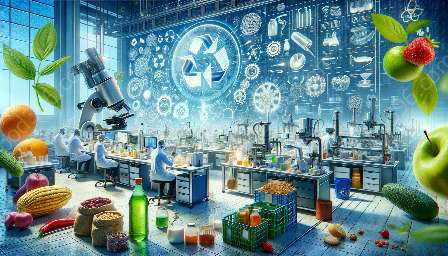Food allergies and intolerances are complex and increasingly prevalent conditions affecting millions of people worldwide. Understanding the science and technology behind these phenomena is essential in developing safe and nutritious food and drink offerings that cater to individuals with different dietary needs.
Understanding Food Allergies
Food allergies are the body's abnormal immune responses to specific foods, triggering a range of symptoms that can vary in severity. This immune system reaction is typically immediate and involves the release of histamine and other chemicals, leading to symptoms such as hives, swelling, difficulty breathing, and in severe cases, anaphylaxis.
Common food allergens include peanuts, tree nuts, shellfish, fish, eggs, milk, soy, and wheat. The prevalence of food allergies has increased significantly in recent decades, prompting extensive research into their causes and potential treatments.
Key Factors in Food Allergies
- Genetic Predisposition: Genetics play a significant role in determining an individual's susceptibility to developing food allergies. People with a family history of allergies are more likely to develop them.
- Environmental Factors: Exposure to certain allergens during early childhood, as well as environmental influences such as pollution and dietary habits, can impact the development of food allergies.
- Gut Microbiota: Research has linked the composition of gut microbiota to the development and management of food allergies, offering insights into potential therapeutic strategies.
Unveiling Food Intolerances
Food intolerances differ from allergies in that they do not involve the immune system. Instead, they arise from the body's inability to properly digest or metabolize certain foods, leading to various symptoms that can range from mild discomfort to severe gastrointestinal issues.
Common food intolerances include lactose intolerance, gluten sensitivity, and fructose malabsorption. Identifying and managing these intolerances requires a comprehensive understanding of their underlying mechanisms.
Factors Contributing to Food Intolerances
- Enzyme Deficiencies: Lactose intolerance, for example, occurs when the body lacks sufficient lactase enzyme to break down lactose, the sugar found in milk and dairy products.
- Food Additives and Chemicals: Certain food additives and chemicals can trigger intolerances, highlighting the importance of ingredient transparency in food and drink products.
- Gastrointestinal Disorders: Conditions such as irritable bowel syndrome (IBS) can exacerbate food intolerances, necessitating tailored dietary management.
The Intersection of Food Science and Technology
Advancements in food science and technology have revolutionized the way we approach food allergies and intolerances. From innovative ingredient substitutions to cutting-edge diagnostics, these developments have paved the way for inclusive and safe food and drink options.
Emerging Trends in Food Allergy Management
- Allergen-Free Ingredients: Food scientists are exploring alternative ingredients to replicate the functionalities of common allergens, allowing for the creation of allergy-friendly products without compromising taste and texture.
- Personalized Nutrition: With the aid of technology, personalized dietary plans tailored to individuals with food allergies are becoming increasingly accessible, empowering individuals to make informed choices.
- Novel Diagnostic Tools: Rapid advancements in diagnostic technologies, such as point-of-care testing and molecular-based assays, are enhancing the accuracy and efficiency of allergy diagnosis and management.
Revolutionizing Food Intolerance Solutions
- Clean Label Initiatives: The clean label movement, emphasizing the use of natural and simple ingredients, aligns with the needs of individuals with food intolerances, fostering transparency and trust in food and drink products.
- Functional Foods: Food technologists are incorporating functional ingredients with digestive health benefits into products, catering to consumers seeking relief from food intolerances.
- Blockchain Technology: Blockchain-enabled traceability systems are enhancing supply chain transparency, offering reassurance to consumers with food intolerances about the origins and handling of their food and drink choices.
Implications for the Food & Drink Industry
The prevalence of food allergies and intolerances has prompted a paradigm shift in the food and drink industry, compelling manufacturers to prioritize inclusivity and safety in their product offerings.
Regulatory Compliance and Labeling
Regulatory bodies worldwide are enacting stringent requirements for allergen and intolerance labeling, mandating clear and accurate information to enable consumers to make informed choices while mitigating risks.
Innovation and Product Development
Market trends are driving substantial innovation in the form of allergen-free, gluten-free, and lactose-free products, signaling a transformative era in the diversification of food and drink options.
Educational Initiatives and Awareness
Advocacy and education campaigns aimed at raising awareness about food allergies and intolerances are fostering a culture of empathy and understanding, promoting inclusivity across the food and drink landscape.
Conclusion
The intersection of food science and technology with the dynamic realm of food allergies and intolerances is reshaping the culinary landscape, empowering individuals with dietary restrictions to enjoy a wide array of safe, nutritious, and delectable food and drink options. With ongoing advancements and a collective commitment to inclusivity, the future promises a world where everyone can savor the joy of food without compromise.

